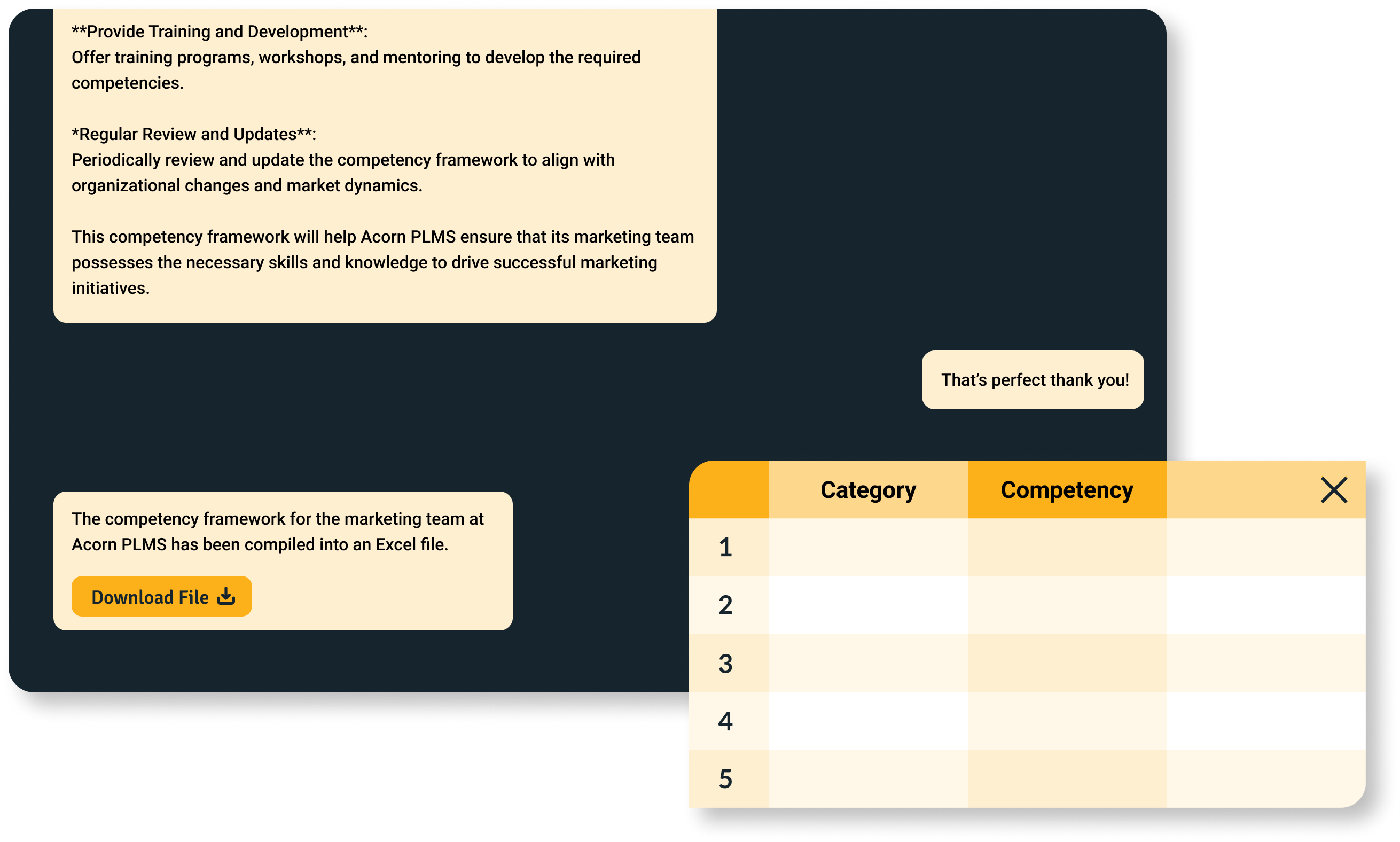A Guide to Understanding the Capability Development Framework
Reading Time:

Lead the pack with the latest in strategic L&D every month— straight to your inbox.
SubscribeA capability development framework is the blueprint for linking workforce growth to business priorities.
In a world where skills age quickly and industries shift overnight, simply hiring for today’s needs isn’t enough. Organizations need a structured way to define, assess, and build the capabilities that’ll drive them forward tomorrow. That’s where a capability development framework comes in.
What is a capability development framework?
A capability development framework is a tool used to define the capabilities—the mix of skills, knowledge, processes, tools, and behaviors—employees need to perform in their roles and achieve business objectives.
Unlike skills frameworks, a capability development framework looks at the bigger picture. Skills are inputs; capabilities are outcomes. A strong framework creates the conditions for:
- Clear recruitment and job design
- Effective career and succession planning
- Consistent performance conversations
- Targeted learning and development
- Smarter workforce planning.
The goal is simple: to create a workforce that not only keeps pace with business needs but drives strategic advantage.
Why you need a capability development framework
Hiring talent with today’s skills solves a short-term problem. A capability development framework solves the long-term one. By defining the capabilities your workforce needs now and in the future, you give every HR and L&D process a strategic anchor.
- Recruitment: Defining the exact capabilities and proficiency levels needed for each role makes choosing candidates more objective.
- Job design and role descriptions: Translates business priorities into clear responsibilities and role expectations.
- Career planning: Gives employees a roadmap for growth (and engagement) by showing which capabilities open up new opportunities and what they need to do to get there.
- Succession planning: Helps identify high-potential employees and develop them for future roles with targeted capability building.
- Performance development: Aligns continuous feedback to organizational strategy by assessing not just outputs but capability maturity throughout your workforce.
- Learning and development: Targets training where capability gaps exist.
- Workforce planning: Ensures the right people with the right capabilities are in the right roles to meet evolving demands.
Linking capability development to performance is why we created the first performance learning management system (PLMS) here at Acorn. A PLMS turns your capability development framework into action, guiding employees to master role-specific capabilities and giving leaders visibility of performance impact. Win-win.
Who is responsible for creating a capability development framework?
A framework can’t be built in isolation. It requires input from both:
- Business leaders and managers, who know which capabilities drive results in their teams.
- HR and L&D leaders, who align those capabilities to organizational strategy and embed them into people processes.
The process should be collaborative and iterative. Leaders identify what’s critical today and what will be critical tomorrow. HR translates this into a framework that can guide recruitment, learning, and development.

Need help defining capabilities for roles, teams, and strategy. Find the right ones in minutes with our Capability Assistant.
BUILD YOUR FRAMEWORKHow advanced is your ability to develop organizational capability?
Not every organization starts at the same place when it comes to capability development. Understanding your level of maturity helps you set realistic goals for your framework and identify what needs to change to progress.
There are four stages of maturity in developing organizational capability.
- Foundational: Capabilities may be defined, but likely inconsistently applied across teams.
- Proficient: Capabilities are embedded in some HR processes like job descriptions or performance reviews, but not enterprise-wide.
- Advanced: Capabilities are integrated across recruitment, succession, workforce planning, and L&D, and you support others in your organization to apply them.
- Strategic: Capabilities are linked to long-term business strategy, with leaders using maturity data to guide investment and transformation.

Most organizations sit somewhere between Proficient and Advanced. The goal isn’t to jump straight to Strategic overnight, but to know your current level, and then use a capability development framework as the pathway to climb higher.
Capability development framework best practices
Unfortunately, a lot of organisations leave their frameworks to gather dust rather than implement them. A capability development framework is only valuable if it’s used. Too many frameworks sit in binders or PDFs without being applied. To avoid that fate, follow these principles.
- Make it unique
- Balance technical and people capabilities
- Use proficiency levels
- Integrate assessment
- Embed in systems, not spreadsheets.
1. Make it unique
Your framework must reflect your organization’s strategy and culture—not a generic template. Without tailoring, a framework won’t provide the clarity or alignment you need.
How to do it:
- Start by reviewing your business objectives. For example, if your strategy includes “expand into international markets,” you may need capabilities like “Cross-Cultural Communication” or “Global Supply Chain Management.” Match the capabilities to outcomes.
- Workshop with leaders to validate which capabilities are truly critical versus “nice to have.”
- Use your framework to codify those strategic priorities into the workforce.
2. Balance technical and people skills
Technical capabilities deliver outputs, but people capabilities like collaboration, adaptability, and leadership determine whether teams can actually execute at scale. Regardless of what your company’s goals are, you’ll need to develop a workforce with both types of capabilities to deliver.
How to do it:
- When designing role profiles, pair technical requirements with people-focused ones. For example:
- – A Data Analyst role should include “Data Modeling” and “Stakeholder Communication.”
- – A Project Manager should show “Budget Management” and “Conflict Resolution.”
- Stress-test your framework by asking: If someone excels technically but fails at collaboration, can they succeed in this role? If not, add people capabilities.
3. Use proficiency levels
Define what capability growth looks like over time. This makes development measurable and transparent.
How to do it:
- Write three to five clear levels of proficiency or performance indicators.
- As an example for “Stakeholder Engagement”:
- – Foundational: Attends meetings with guidance.
- – Developing: Communicates with stakeholders independently.
- – Proficient: Builds ongoing relationships and manages expectations.
- – Advanced: Coaches others on engagement strategies.
- – Expert: Shapes organizational policy on stakeholder management.
- Make these levels part of ongoing conversations, not just annual reviews.
- – During onboarding, so employees know what “good” looks like in their role from day one.
- – In regular check-ins or one-on-ones between employees and managers to track progress in real time.
- – When setting development plans, so growth steps are explicit.
- – And yes, in performance conversations—but as a reflection of continuous conversations, not the only touchpoint.
4. Integrate assessment
A framework isn’t a static PDF. It should drive assessment and measurement of progress on a regular basis.
How to do it:
- Run capability self-assessments and manager assessments at frequent intervals (we do every six weeks at Acorn).
- Use results to create heatmaps that show where capabilities are strong and where gaps exist.
- – For example, if “Cybersecurity Awareness” rates low across multiple teams, there’s your priority for targeted training.
- Feed results back into career development conversations so employees are getting actionable advice for progression.
5. Embed in systems, not spreadsheets
A capability framework should live where your people do their learning and performance conversations—not in siloed files and notes.
How to do it:
- Implement your framework in a platform like a performance learning management system (PLMS).
- – Say, when an employee completes a mentoring cycle, the PLMS triggers a new assessment for them and their mentor to reevaluate their proficiency in “Team leadership”.
- Automate workflows so onboarding triggers a baseline assessment or role changes trigger a reassessment. This ensures the framework is used continuously, not once a year.
Key takeaways
If you want to build a workforce that delivers on strategy, you need more than job descriptions, skill lists, and that dusty old LMS.
You need a capability development framework to:
- Define the workforce capabilities that matter most
- Align recruitment, learning, performance, and workforce planning to strategy
- Provide a roadmap for employees to grow and for your organization to stay competitive.
The most effective frameworks are unique to you, balanced, measurable, and embedded into daily practice. When paired with the right platform—like a PLMS—they move from theory to traction, turning workforce development into business performance.